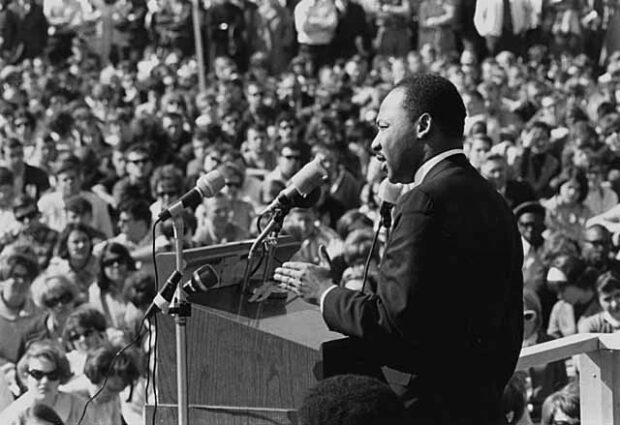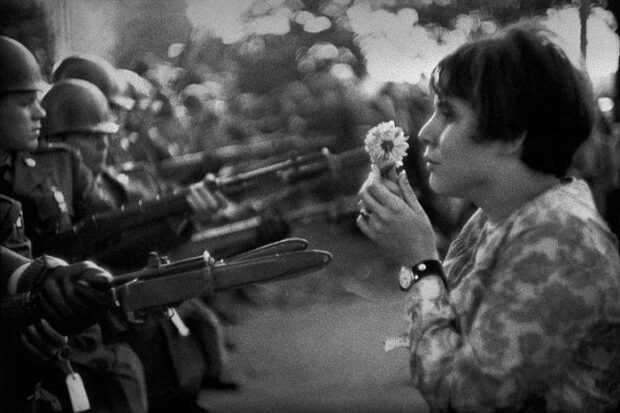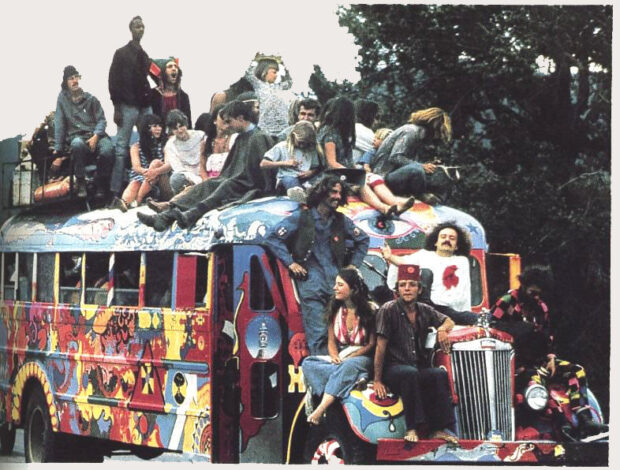While individual members of the African-American elite took one symbolic hurdle after another, this did little to change the extreme poverty of the vast majority of blacks. They often lived in inhumane “Third World” conditions in city centers.
Slums expanded even in the immediate vicinity of the Capitol, an extremely embarrassing situation for the superpower USA. The struggle for legal equality had bridged rifts. But King’s intervention – not that of any radical, but that of the visionary of the “color-blind society” – exposed the lies of the American dream. He insisted that there was a connection between the Vietnam War, in which a disproportionately large number of African American soldiers died, an ongoing “institutional racism” and the almost insoluble problem of poverty. He explained to critics that the principles of nonviolence should not be limited to the US itself, but also apply to its international relations.
These warnings were sadly confirmed when bloody riots broke out in numerous cities in the United States in the summer of 1967, the worst being the race riots in Newark and then in Detroit, with 41 dead there alone. Of course, King condemned the pointless looting and killing. But at the same time, he implored Johnson in a telegram: The social unrest was the result of the government’s inaction, which sent soldiers instead of organizing job creation measures. The president was outraged by the “ungrateful negro”.
READ: How did the Struggle for Equality Begin: 1967 in the USA
King, for his part, stepped up the pace. Since the fall of 1967, he has been preparing another star march on Washington, which, following the example of the successful civil rights marches, but also the protest marches of impoverished veterans and unemployed in the 1930s, should force Congress to pass aid programs. This poor people’s campaign targeted all the underprivileged, not just blacks, but also poor whites, indigenous people, and Latinos. But the Nobel Prize laureate found little understanding of this.

In his 1967 Christmas sermon, which was only broadcast on Canadian radio, he saw his vision of his most famous speech from 1963 disappointed: “I saw my dream turned into a nightmare.”
The equality campaign exposed the lack of support from urban, white, predominantly non-Anglo-Saxon voters (Irish, also Poles and Italians, in rural areas Iro-Scots). These represent the historical basis of the Democratic Party. For them, instead of class questions, the question of race became the mostly unspoken point of orientation.
This weakened the Democrats, especially since they, as the historically hegemonic party of the South, had stood there on the other side of the civil rights struggle and from their ranks with the former governor of Alabama, George Wallace, a die-hard advocate of racial segregation, began to stand up for himself in the fall of 1967 Advertise Third-Party Candidate.
In 1968 he was supposed to take decisive votes from the Democrats. Wallace had earned his name as a die-hard segregationist with his infamous stand in the schoolhouse door – an incident in November 1963 when he personally blocked two African American students from entering the University of Alabama.
The women’s movement was also fermenting in 1967. On the one hand, it also had great successes. The Civil Rights Act of 1964 forbade both racial and gender-based discrimination in the workplace. On the other hand, however, the mills of the judiciary and anti-discrimination agencies were grinding too slowly for many women’s rights activists to quickly overcome patriarchal structures.
READ: Why We Can’t Climb the Torch of the Statue of Liberty: the Reasons are Kept in History
The National Organization of Women resumed the campaign for an Equal Rights Amendment to the Constitution at its first annual meeting in 1967. NOW, an organization supported mainly by well-trained, working women without a mass following, now increasingly aimed at actively overcoming social gender differences.
Initially within the New Left, for example, the group New York Radical Women was founded in 1967. In view of the undisguised sexism of many male protesters, whose understanding of roles suspiciously resembled that of their fathers, these women wondered how the ideals of a participatory democracy could be realized in a patriarchal society.
Because even in progressive milieus, female bodies were often subject to male control, also in view of a rather one-sided understanding of “sexual freedom”. Such positions, which sounded radical at the time, were not compatible with most American middle-class women.
For many Americans of the “hard-working” working class and middle class, questions of the social dealings with sexuality were the most obvious stumbling block for many Americans of the “hard-working” working-class and middle-class Protagonists of the counterculture with a feeling for scandals celebrated rejection of everything that could be understood under established social norms, the guardians of the grail saw themselves deliberately provoked by “family values”.
Both sides oriented themselves to the fifties as a mythical reference point of an allegedly ideal world or a damnable conformism. At the same time, the counterculture was fueled by the media in 1967 to become a fashion phenomenon and thereby turned into its opposite. The summer of love in San Francisco, which in retrospect was transfigured as a festival of expanding social awareness, ended in an orgy of crime and sexual violence.

The origins of counter culture lie in several places, including New York, in the beat culture of the late 1950s. In 1967 its epicenter finally shifted to the west coast, when San Francisco became a pilgrimage destination for numerous so-called “flower children”.

The term “hippie”, which was somewhat unclear in its origins, was picked up by the media in 1967 and popularized.
The television documentary “The Hippie Temptation” gave warnings from worried psychologists and educators about the relaxed life of the “hipsters” in San Francisco, and with powerful images, it even promoted the sweet, libertarian life in the climatically favored, beautiful city in the west. 50,000, 100,000 “flower children”, according to the prognosis, would unite in a “summer of love”.
READ: Restore Penn Station: New York’s New Art Object
The hordes of young people, some of them extremely naive, gradually transformed the trendy Haight-Ashbury district, originally a poor black neighborhood, into a slum since the spring break in 1967. They saw themselves betrayed and sold by drug dealers. Petty crime, including mass rape of unprotected young girls, but also young men, was the order of the day and was astonishingly little punished.
Like us on Facebook for more stories like this: